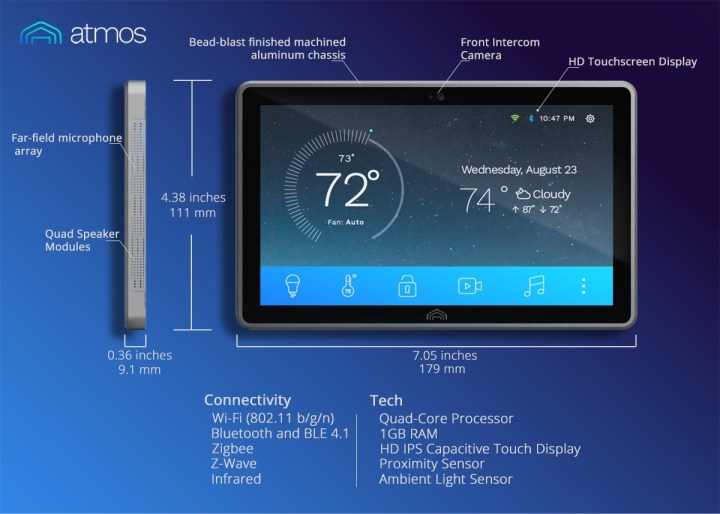
The platform is an ambitious effort to solve the challenge of technological fragmentation, a challenge facing many smart home enthusiasts who find themselves overwhelmed by an array of networks, standards, and devices being used to connect and control consumer devices. One of Atmos’ major successes is incorporating mass compatibility into its devices. The Atmos Smart Home Control platform is compatible with every major smart home or home-automation standard that currently exists including Wi-Fi, Bluetooth and Bluetooth Low Energy (BLE), Zigbee, Z-Wave, and even infrared for truly old-school devices like television remotes. The full list of compatible brands is available at atmoshome.tech.
The control system works across all these standards, allowing Atmos to pair with standard home-automation brands including Nest, Philips Hue, and DirecTV, as well as connect to entertainment platforms like Apple TV, Roku, and Sonos. The voice-activated touchscreen control lets users dim lights, lock doors, play music, control appliances, and even order services like Uber or Lyft or even takeout. Atmos has also added in more complex functions —the control system can act as a personal assistant, as well as enable video chat via the intercom feature not only from room-to-room but also with friends and family outside the house through the Atmos mobile app.
The Atmos Smart Home Control System is housed in a roughly 4-inch by 7-inch machined aluminum chassis, and runs on a quad-core processor with one gig of RAM. The HD touchscreen display is augmented by a front intercom camera, a proximity sensor, an ambient light sensor, and a far-field microphone array.
The Tampa, Florida-based project is the brainchild of co-founders Mark Lyle, chief technology officer, and Chris Ladwig, chief design officer, who have been financing the project via a Title III equity crowdfunding project that has raised more than $73,000 already toward a project goal of $107,000. (Those unfamiliar with crowdfunding can read our story on how to back projects the smart way.)
“Smart home technologies are intended to help us streamline and manage our homes and our lives,” said Lyle. “However, most smart home devices don’t speak the same language, so trying to set up, access, and control multiple devices, each of which respond to a different smartphone app or communication protocol, can be frustrating, inconvenient, and time-consuming.”
The company has other ambitions for entering the smart home marketl. The first product in the development pipeline is the Atmos Expand Smart Light Switch, a device that controls smart lighting via a high-resolution touchscreen using the main Atmos Smart Home Control system, their voice, or their phone. The company also has a proprietary technology that allows the smart lighting system to function normally even if the Wi-Fi goes down.
The other product in the pipeline potentially pits Atmos against behemoths like Amazon and Google in the smart speaker market. The Atmos Surround Smart Speaker claims to offer a much higher performance audio experience compared to other smart speakers. In addition to voice control and a touchscreen, the device is also tightly integrated with the Atmos Smart Home Control system, allowing users to utilize any Atmos-connected smart devices hands-free. No word yet on how much these devices will cost, but we’ll keep you posted.


